The Old Curiosity Club discussion
Little Dorrit
>
Little Dorrit Chapters Chp 12-14
date newest »
newest »
 newest »
newest »
 Oh, Tristram - perhaps you could write a book for children on altruism. Probably a best seller. This is funny - I really did laugh out loud. I will watch for you to approach the Christmas kettle next year and put a lot of coins in to get your attention.
Oh, Tristram - perhaps you could write a book for children on altruism. Probably a best seller. This is funny - I really did laugh out loud. I will watch for you to approach the Christmas kettle next year and put a lot of coins in to get your attention. And thanks for such a good job as moderator/explainer - or whatever your title is. This is an excellent site and I, for one, learn a lot from all of you. peace, janz
Tristram wrote: "Thank you, janz!!!"
Poor, poor Tristram's son. Come to think of it I'm pretty sure I say that often, he probably does the same.
Poor, poor Tristram's son. Come to think of it I'm pretty sure I say that often, he probably does the same.
Here is an illustration for this installment I found by an artist I never heard of before. More below.
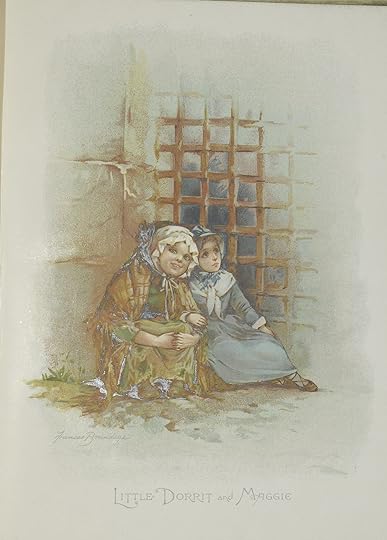
Little Dorrit and Maggy
Frances Brundage
CHILDREN’S STORIES FROM DICKENS, RE-TOLD BY HIS GRAND-DAUGHTER AND OTHERS.
1900
More about the artist:
Frances Isabelle Lockwood Brundage (1854–1937) was an American illustrator best known for her depictions of attractive and endearing children on postcards, valentines, calendars, and other ephemera published by Raphael Tuck & Sons, Samuel Gabriel Company, and Saalfield Publishing. She received an education in art at an early age from her father, Rembrandt Lockwood. Her professional career in illustration began at seventeen when her father abandoned his family and she was forced to seek a livelihood.
In addition to ephemera, Brundage illustrated children's classics such as the novels of Louisa May Alcott, Johanna Spyri, and Robert Louis Stevenson, and traditional literary collections such as The Arabian Nights and the stories of King Arthur and Robin Hood. She was a prolific artist, and, in her late 60s, was producing as many as twenty books annually. Her work is highly collectible.
She sold her first professional work – a sketch illustrating a poem by Louisa May Alcott – to the author. She illustrated books and ephemera such as paper dolls, postcards, valentines, prints, trade cards, and calendars. Her book illustrations were sometimes published as postcards.
In 1886, she married the artist, William Tyson Brundage, and gave birth to one child, Mary Frances Brundage, who died in 1891 aged 17 months. The Brundages resided in Washington, D.C., summered at Cape Ann, Massachusetts, and, in later years, moved to Brooklyn, New York. They occasionally worked jointly on projects.
Brundage produced works for Raphael Tuck & Sons with an emphasis on attractive and endearing Victorian children. At the same time she was also published by Wolff Hagelberg, Berlin, in near equal amount, except no book illustration and quite different subject and style. Maud Humphrey was the preferred artist with American publishers in the 1890s, but Brundage was chosen by Tuck, London, and Hagelberg, Berlin, international art publishers, for their American market publication. As a result, Brundage had extensive early Euro and UK international postcard publication, more than any other children artist except Ellen Clapsaddle and Harriett M. Bennett, as well as with Tuck's and Hagelberg's large lines of U.S. postcards. Those postcards and the Tuck and the Hagelberg lines of fancy die cut valentines made Brundage the largest presence in U.S. art paper 1899-1910. By 1910, she was working for New York publisher, Samuel Gabriel Company (S. Gabriel had been manager of Tuck's U.S. publishing operations and was responsible for Tuck's use of Brundage for book illustration and postcards), and later, Akron, Ohio publisher, Saalfield. She also did illustrated books for Stecher Lithographic Company, DeWolfe, Fiske & Company, Fred A. Stokes, Charles E. Graham & Company, and E.P. Dutton & Ernest Nister—and work for Hayes & Koerner. later Hayes Co.. During her late 60s, she produced as many as 20 books per year (exaggeration!). Brundage died on March 28, 1937, aged 82 years.
Brundage was notable for ethnic illustrations as early as 1886 for Louis Prang, 1890 and 1892 for W. Hagelberg, and for Tuck valentines and postcards in the early 1900s. While "stereotypical" in form, they were not negative and might be compared to her "comical" treatment of romance with Tuck die cut valentine and postcard images where the intent is not ridicule but rather positive dramatization. For example, an 1892 Cincinnati merchant's greeting card image shows pugnacious Irish girl in rags, black girl in rags, well-dressed white girl, dignified oriental girl, and sober American Indian girl with bow and arrows—all smiling and holding hands (except the sober American Indian girl), the point being friendship and human worth regardless of ethnicity and social status...not quite the stereotypical attitude of the time and very much an expression of the American social ideal as we think of it today.

Little Dorrit and Maggy
Frances Brundage
CHILDREN’S STORIES FROM DICKENS, RE-TOLD BY HIS GRAND-DAUGHTER AND OTHERS.
1900
More about the artist:
Frances Isabelle Lockwood Brundage (1854–1937) was an American illustrator best known for her depictions of attractive and endearing children on postcards, valentines, calendars, and other ephemera published by Raphael Tuck & Sons, Samuel Gabriel Company, and Saalfield Publishing. She received an education in art at an early age from her father, Rembrandt Lockwood. Her professional career in illustration began at seventeen when her father abandoned his family and she was forced to seek a livelihood.
In addition to ephemera, Brundage illustrated children's classics such as the novels of Louisa May Alcott, Johanna Spyri, and Robert Louis Stevenson, and traditional literary collections such as The Arabian Nights and the stories of King Arthur and Robin Hood. She was a prolific artist, and, in her late 60s, was producing as many as twenty books annually. Her work is highly collectible.
She sold her first professional work – a sketch illustrating a poem by Louisa May Alcott – to the author. She illustrated books and ephemera such as paper dolls, postcards, valentines, prints, trade cards, and calendars. Her book illustrations were sometimes published as postcards.
In 1886, she married the artist, William Tyson Brundage, and gave birth to one child, Mary Frances Brundage, who died in 1891 aged 17 months. The Brundages resided in Washington, D.C., summered at Cape Ann, Massachusetts, and, in later years, moved to Brooklyn, New York. They occasionally worked jointly on projects.
Brundage produced works for Raphael Tuck & Sons with an emphasis on attractive and endearing Victorian children. At the same time she was also published by Wolff Hagelberg, Berlin, in near equal amount, except no book illustration and quite different subject and style. Maud Humphrey was the preferred artist with American publishers in the 1890s, but Brundage was chosen by Tuck, London, and Hagelberg, Berlin, international art publishers, for their American market publication. As a result, Brundage had extensive early Euro and UK international postcard publication, more than any other children artist except Ellen Clapsaddle and Harriett M. Bennett, as well as with Tuck's and Hagelberg's large lines of U.S. postcards. Those postcards and the Tuck and the Hagelberg lines of fancy die cut valentines made Brundage the largest presence in U.S. art paper 1899-1910. By 1910, she was working for New York publisher, Samuel Gabriel Company (S. Gabriel had been manager of Tuck's U.S. publishing operations and was responsible for Tuck's use of Brundage for book illustration and postcards), and later, Akron, Ohio publisher, Saalfield. She also did illustrated books for Stecher Lithographic Company, DeWolfe, Fiske & Company, Fred A. Stokes, Charles E. Graham & Company, and E.P. Dutton & Ernest Nister—and work for Hayes & Koerner. later Hayes Co.. During her late 60s, she produced as many as 20 books per year (exaggeration!). Brundage died on March 28, 1937, aged 82 years.
Brundage was notable for ethnic illustrations as early as 1886 for Louis Prang, 1890 and 1892 for W. Hagelberg, and for Tuck valentines and postcards in the early 1900s. While "stereotypical" in form, they were not negative and might be compared to her "comical" treatment of romance with Tuck die cut valentine and postcard images where the intent is not ridicule but rather positive dramatization. For example, an 1892 Cincinnati merchant's greeting card image shows pugnacious Irish girl in rags, black girl in rags, well-dressed white girl, dignified oriental girl, and sober American Indian girl with bow and arrows—all smiling and holding hands (except the sober American Indian girl), the point being friendship and human worth regardless of ethnicity and social status...not quite the stereotypical attitude of the time and very much an expression of the American social ideal as we think of it today.
Here we have Little Dorrit's Vestry by Arthur Moreland:
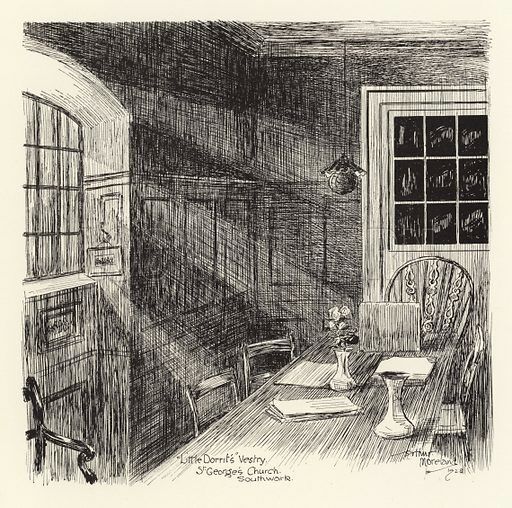
Little Dorrit's Vestry
St George’s Church, Southwark
Illustration for Dickens in London, Forty-Seven Drawings by Arthur Moreland 1928.
I haven't found the other forty six drawings yet.

Little Dorrit's Vestry
St George’s Church, Southwark
Illustration for Dickens in London, Forty-Seven Drawings by Arthur Moreland 1928.
I haven't found the other forty six drawings yet.
Another new illustration by a new artist, new to me anyway:
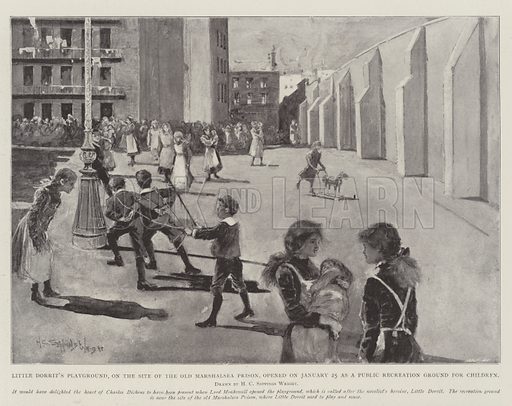
Little Dorrit's Playground, on the Site of the Old Marshalsea Prison, opened on 25 January as a Public Recreation Ground for Children. Illustration for The Illustrated London News, 8 February 1902.
Henry Charles Seppings Wright, Artist
More about the artist:
Henry Charles Seppings Wright (1849–1937) was an English artist, illustrator, war correspondent, and author. Born in January 1849 at Stithians, Redruth, Cornwall, Wright was the son of a clergyman, the Rev. Francis Hill Arbuthnot Wright. In 1881, Wright, aged 32, was a painter and was living with his parents at Pendleton. His father was then Vicar of St Paul's, Paddington.
Wright contributed caricatures to Vanity Fair under the pseudonym "Stuff" and also worked for the Illustrated London News. He served as a war correspondent in Tripoli and with Tōgō's navy and wrote two illustrated books about his experiences; With Togo: The Story of Seven Months' Active Service Under His Command (1905) and Two Years Under the Crescent (1913) which he illustrated.
Wright participated in the looting of Benin City during the British Benin Expedition of 1897. In 1884, Wright married Marie Eliza Willows in Croydon.
At the census of 1901, Wright was living at Roxborough Park, Harrow on the Hill, with his wife, Marie Seppings Wright, and children Frank, 15, Nellie, 14, and Stamford, 7. He gave his occupation as War Correspondent and the family had a cook and housemaid.
On 6 October 1927, Wright married secondly Charlotte Yellowley Loftus Brock at the Church of St Barnabas, Pimlico. He died in 1937.
I wonder what happened to the first wife.

Little Dorrit's Playground, on the Site of the Old Marshalsea Prison, opened on 25 January as a Public Recreation Ground for Children. Illustration for The Illustrated London News, 8 February 1902.
Henry Charles Seppings Wright, Artist
More about the artist:
Henry Charles Seppings Wright (1849–1937) was an English artist, illustrator, war correspondent, and author. Born in January 1849 at Stithians, Redruth, Cornwall, Wright was the son of a clergyman, the Rev. Francis Hill Arbuthnot Wright. In 1881, Wright, aged 32, was a painter and was living with his parents at Pendleton. His father was then Vicar of St Paul's, Paddington.
Wright contributed caricatures to Vanity Fair under the pseudonym "Stuff" and also worked for the Illustrated London News. He served as a war correspondent in Tripoli and with Tōgō's navy and wrote two illustrated books about his experiences; With Togo: The Story of Seven Months' Active Service Under His Command (1905) and Two Years Under the Crescent (1913) which he illustrated.
Wright participated in the looting of Benin City during the British Benin Expedition of 1897. In 1884, Wright married Marie Eliza Willows in Croydon.
At the census of 1901, Wright was living at Roxborough Park, Harrow on the Hill, with his wife, Marie Seppings Wright, and children Frank, 15, Nellie, 14, and Stamford, 7. He gave his occupation as War Correspondent and the family had a cook and housemaid.
On 6 October 1927, Wright married secondly Charlotte Yellowley Loftus Brock at the Church of St Barnabas, Pimlico. He died in 1937.
I wonder what happened to the first wife.
Hey, I found another one by Arthur Moreland! That's two down, forty five to go;
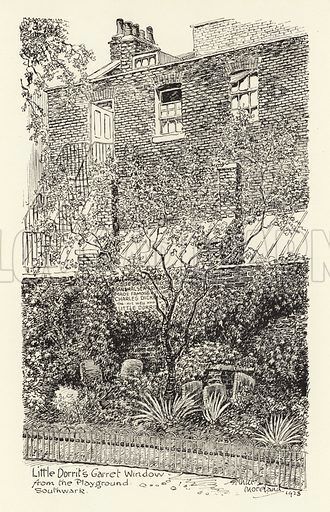
Little Dorrit’s Garret Window, from the Playground
Illustration for Dickens in London, Forty-Seven Drawings by Arthur Moreland

Little Dorrit’s Garret Window, from the Playground
Illustration for Dickens in London, Forty-Seven Drawings by Arthur Moreland
And another:
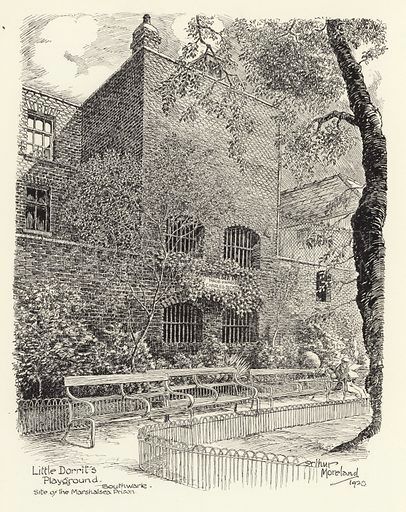
Little Dorrit’s Playground, Southwark, Site of the Marshalsea Prison.
Illustration for Dickens in London, Forty-Seven Drawings by Arthur Moreland.

Little Dorrit’s Playground, Southwark, Site of the Marshalsea Prison.
Illustration for Dickens in London, Forty-Seven Drawings by Arthur Moreland.
 Kim wrote: "Frances Brundage..."
Kim wrote: "Frances Brundage..."While this specific picture was not familiar to me, the style certainly was. I feel as if I've seen Brundage's work many times in many places. After reading this, when I see any of her work in the future I'm sure it will pop out at me. It's very sweet in its way but, as children's illustrators go, I prefer Jessie Willcox Smith.
Thanks Kim
More and more I am amazed by the industry that has grown around all things related to Dickens.
More and more I am amazed by the industry that has grown around all things related to Dickens.
Kim wrote: "Here is an illustration for this installment I found by an artist I never heard of before. More below.
Little Dorrit and Maggy
Frances Brundage
CHILDREN’S STORIES FROM DICKENS, RE-TOLD BY HIS ..."
Kim
Thank you for this. I knew nothing of Brundage. So many illustrators out there for me yet to discover. She certainly illustrated many of the classics.
Little Dorrit and Maggy
Frances Brundage
CHILDREN’S STORIES FROM DICKENS, RE-TOLD BY HIS ..."
Kim
Thank you for this. I knew nothing of Brundage. So many illustrators out there for me yet to discover. She certainly illustrated many of the classics.
Kim wrote: "And another:
Little Dorrit’s Playground, Southwark, Site of the Marshalsea Prison.
Illustration for Dickens in London, Forty-Seven Drawings by Arthur Moreland."
Like Moreland very much. There is an incredible amount of fine detail in the illustrations. There is certainly a romantic feel to them. They make the Marshalsea seem rather idyllic. Much different from Phiz. I wonder what Dickens would have thought about how much these illustrations differ from the way he described the prison.
Little Dorrit’s Playground, Southwark, Site of the Marshalsea Prison.
Illustration for Dickens in London, Forty-Seven Drawings by Arthur Moreland."
Like Moreland very much. There is an incredible amount of fine detail in the illustrations. There is certainly a romantic feel to them. They make the Marshalsea seem rather idyllic. Much different from Phiz. I wonder what Dickens would have thought about how much these illustrations differ from the way he described the prison.
 Tristram wrote: "Peacejanz wrote: "Folks, there is some research within the last 30-40 years that shows altruism makes us feel good and live more happily. There is also some research showing that those seeing some ..."
Tristram wrote: "Peacejanz wrote: "Folks, there is some research within the last 30-40 years that shows altruism makes us feel good and live more happily. There is also some research showing that those seeing some ..."But did you feel good (not about lecturing your son) about letting other folks in. It is about you feeling good about your service to the world. Your son is another issue entirely - you are supposed to feel good when he is elected governor and does an honest job and helps the general public. Have to wait on that, I guess, in that you are still driving him around. Later. peace, janz
Hmmm, the question of whether it is good to let other folks in on telling to your son it is not good to let other in on all the good you do is like those steps in the Escher drawings.
 Tristram wrote: "Hmmm, the question of whether it is good to let other folks in on telling to your son it is not good to let other in on all the good you do is like those steps in the Escher drawings."
Tristram wrote: "Hmmm, the question of whether it is good to let other folks in on telling to your son it is not good to let other in on all the good you do is like those steps in the Escher drawings."Ha!
 Moreland's illustrations make the Marshalsea look like a delightful urban park. The interior picture shows a long table with at least five chairs around it, and topped with vases, one of which has flowers in it. And is that a wardrobe or a china cabinet? Either way, he seems to be living pretty high on the hog for someone in debtor's prison.
Moreland's illustrations make the Marshalsea look like a delightful urban park. The interior picture shows a long table with at least five chairs around it, and topped with vases, one of which has flowers in it. And is that a wardrobe or a china cabinet? Either way, he seems to be living pretty high on the hog for someone in debtor's prison. I remember reading a non-fiction book once that talked about early immigrants' only piece of furniture being their shipping trunk, which had multiple uses - as storage, a table, or a seat for one or two when there wasn't food being served on it. Why does Dorrit need FIVE or more chairs? For all his guests?
So, yeah... I think either Moreland was WAAAAAY off in his depiction, or William is more ridiculous than we even thought. Certainly he could have sold those belongings to pay off some of his debt. But then he might have to actually work for a living, something for which he's obviously not suited.
Tristram wrote: "Hmmm, the question of whether it is good to let other folks in on telling to your son it is not good to let other in on all the good you do is like those steps in the Escher drawings."
Well that just made my head ache.
Well that just made my head ache.
Mary Lou wrote: "Moreland's illustrations make the Marshalsea look like a delightful urban park. The interior picture shows a long table with at least five chairs around it, and topped with vases, one of which has ..."
I can imagine that our illustrous friend Mr. Dorrit needs every single one of those chairs because people have to pay him so much homage that they need to sit down while doing it since otherwise they would probably not come anymore and then there would be a shortage in testi ... ahem ... monials.
I can imagine that our illustrous friend Mr. Dorrit needs every single one of those chairs because people have to pay him so much homage that they need to sit down while doing it since otherwise they would probably not come anymore and then there would be a shortage in testi ... ahem ... monials.






I think that Dickens, who was doubtless strongly opposed to the ..."
It’s often dangerous ground to read too much of Dickens’s personal biography into his novels — although I constantly do. Dickens expected much from his daughters in terms of attention and loyalty. On the other hand, he was quite eager to send his sons out into the world to make their way as soon as possible. I often wonder how much he was attempting to mold his own children into the world he controlled in his novels.